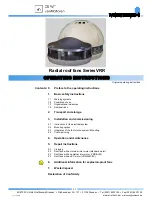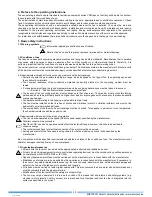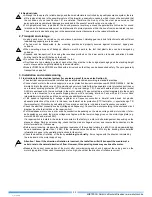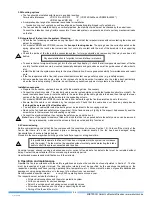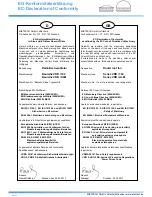
03
MIETZSCH GmbH Lufttechnik Dresden
s
www.mietzsch.de
1.4 Residual risks
Although the fans are of a reliable design and their manufacture is controlled by a quality assurance system, there is
still a residual risk due to the possible rupture of the impeller, especially in cases in which it cannot be excluded that
the conditions of use (see Section 1.2) are violated. Therefore, the vicinity of the fan must be secured so that
personal injuries and material damage are excluded in the event of a malfunction or an accident.
For high-powered fans, in particular, the sound pressure level may exceed the permissible limit value for sound
immissions. Suitable measures must be implemented to protect persons within this zone from noise-related injuries.
The sound immission data are given in the associated contract documents or the relevant brochures.
2. Transport and storage
Loading work must be carried out by experienced personnel. Hoisting gear and hoist attachments with sufficient
load-bearing capacity are to be used.
The fan must be transported in the mounting position and properly secured against movement, tipping and
collisions.
When selecting a means of transport, attention must be paid to the fact that plastic fans can be damaged by
collisions.
Suspend and transport roof fans using the recesses provided on the lower section to handle and attach 4-cable
hoisting tackle. Never lift the fan by the hood.
Do not use the motor's lifting lugs to suspend the fan.
If roof fans are to be stacked on top of each other, they must be in their original packaging and the stacking height
must not exceed the height stipulated by the manufacturer.
Models VRR400 and VRR 500 are fitted with a drive lock so that they can be transported safely. They are generally
transported on a pallet.
3. Installation and commissioning
3.1 Instructions for the electrical system (for explosion-proof fans, see also Section 6.)
The electrical equipment must be installed by a qualified electrician according to standard practices.
Connect each motor to the mains supply via a motor protection device in accordance with DIN EN 60204-1. Set the
bimetallic trip to the rated current. For pole-changing motors, install either two separate motor protection switches or
one thermal winding protection (PTC thermistor --> special design TS). Fans with external rotor motors (model
ALM) are equipped with thermocontacts in the motor winding. These contacts are either integrated into the supply
cable or are connected to a separate tripping device with a reclosing interlock. Fans with an EC motor have
integrated motor protection and thus do not require additional measures.
If the speed is regulated by a voltage regulator or a frequency converter, a bimetal switch does not provide
adequate protection of the motor. In this case, use thermal motor protection (PTC thermistor --> special design TS;
thermocontacts). Protection by calculating I²t can also be used; this is included in most frequency converters.
Check the electrical connection values (voltage and frequency). Connect the motor according to the enclosed circuit
diagram (see the terminal box or the repair switch).
For three-phase motors, use a star or delta connection, depending on the mains voltage and motor model. If star-
delta switches are used, the mains voltage must agree with the lower voltage given on the motor type plate (e.g.
motor 400/690V and mains 400V).
If a repair switch is installed, the motor is connected in the factory in a star or delta arrangement, depending on the
planned voltage. During commissioning, check that the mains voltage is correct, and reverse the connections in the
motor terminal box, if necessary.
Before commissioning, measure the insulation resistance of the winding relative to earth. Dry and as-new windings
have a resistance greater than 10 M
W
. If the measured value lies below 2 M
W
, dry the winding. More detailed
information is given in the operating instructions for the motor.
Check the direction of rotation
of the fan by
switching it on briefly
. It must agree with the direction indicated by
the red arrow on the motor support ring.
Attention! Even if the direction of rotation is incorrect, the radial fan will still transport the medium at a
certain rate in the normal direction of flow. However, this operating mode may overload the motor.
Measure the current consumption of the motor after commissioning and check it against the value given on the
motor's type plate. If the current consumption is too high, check that the direction of rotation is correct.
!
!
!
!
!
oi_vrr (11/09)

